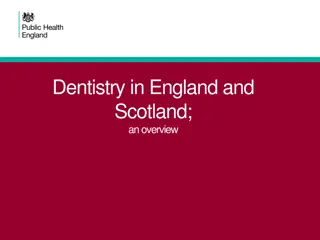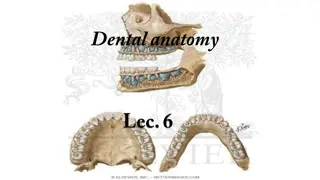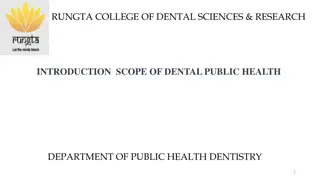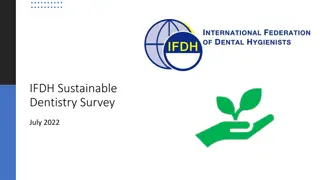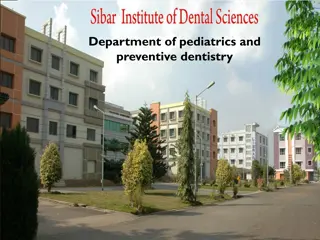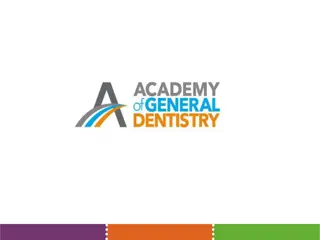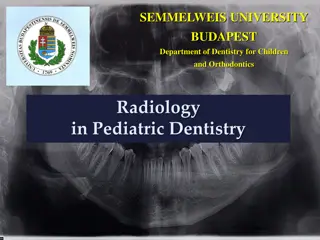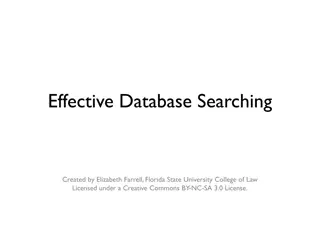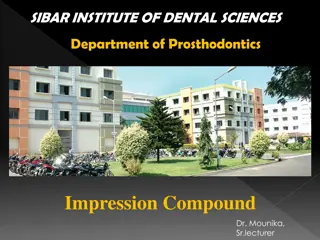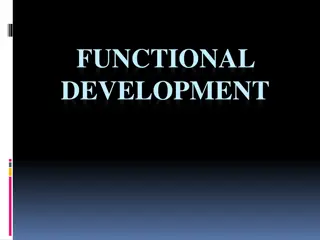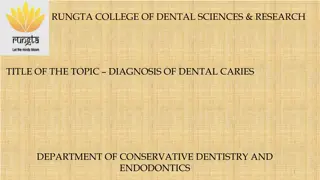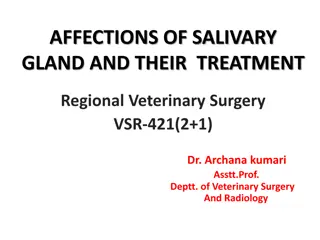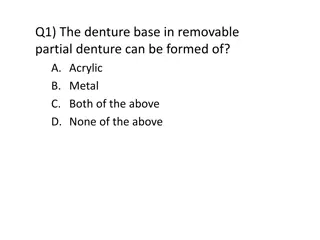Understanding Mandibular Major Connectors in Dentistry
Mandibular major connectors in dentistry are crucial components that must be designed carefully to ensure patient comfort and stability. These connectors should be rigid yet not bulky to avoid impinging on oral structures. Various types, such as lingual bars and plates, serve different purposes based on space availability. Proper relief and rounding of the connectors are essential for a comfortable fit.
Download Presentation

Please find below an Image/Link to download the presentation.
The content on the website is provided AS IS for your information and personal use only. It may not be sold, licensed, or shared on other websites without obtaining consent from the author. Download presentation by click this link. If you encounter any issues during the download, it is possible that the publisher has removed the file from their server.
E N D
Presentation Transcript
Mandibular Major Connectors 12/17/201 1 6
In general, mandibular major connectors are long and relatively narrow. Therefore, special consideration must be given to the design of such connectors. Mandibular connectors must be rigid without being so bulky that they compromise patient comfort. Furthermore, mandibular major connectors must not impinge upon the movable floor of the mouth, the associated frena, or mandibular tori. 12/17/201 6 2
At the inferior border of the lingual bar connector, the limiting factor is the height of the moving tissue in the floor of the mouth. Because the connector must have sufficient width and bulk to provide rigidity, a linguo-plate is commonly used when space is insufficient for a lingual bar. 12/17/201 3 6
If less than 8 mm exists between gingival margins and the movable floor of the mouth, A linguoplate, a sublingual bar, or a continuous bar is preferred as a major connector. Relief is provided for soft tissue under all portions of the mandibular major connector and at any location where the framework crosses the marginal gingiva. The inferior border of mandibular major connectors should be gently rounded after being cast to eliminate a sharpedge. 12/17/201 6 4
4 types of Mandibular Major Connectors Lingual bar Lingual plate Double lingualbar Labial bar 12/17/201 6 5
Lingual bar The lingual bar is perhaps the most frequently used mandibular major connector. 12/17/201 6 6
The basic form of a mandibular major connector is a half pear shape, located above moving tissue but as far below the gingival tissue as possible. It is usually made of reinforced, 6 gauge, half pear shaped wax or a similar plastic pattern. Placement of a lingual bar requires at least 8 mm of space between the gingival margins and the floor ofthe mouth. This major connector to have a minimum height of 5 mm and allows 3 mm of space between the gingival margins and the superior border of the bar. permits the 12/17/201 6 50
A periodontal probe may be used to measure from the gingival margins to the floor of the mouth. The patient instructed to protrude the tongue so that its tip touches the vermilion upper lip. Intraoral measurements may be transferred to the corresponding dental cast. should elevate and be the border of 12/17/201 6 8
The presence of mandibular tori complicates the design, fabrication, and placement of lingual bar major connectors. Surgical removal of mandibular tori usually is required for successful removable partial denture therapy. Indicated in Kennedy s Class III situation and its modifications. 12/17/201 9 6
Advantages: Simple, easy to design and fabricate Has no minimal contact with oral tissue No contact with teeth, so no decalcification of teeth. Disadvantages: If extreme care is not taken in the design and construction of a lingual framework may not be rigid. Cause food entrapment and patient discomfort if it is placed over undercut bar, the resultant ifficult to used when tori are pre12s/1e 7/2n 01t 6 10
Lingual Plate/ Linguoplate The structure of a lingual plate is basically that of a half- pear-shaped lingual bar with a thin, solid piece of metal extending from its superior border. . 12/17/201 6 11
The inferior border of a lingual plate should be positioned as low in the floor of the mouth as possible, but should not interfere with the functional movements of the tongue and soft tissues. A linguoplate made technically should be contoured follow the contours of the teeth and the embrasures should be as as thin feasible to is and 12/17/201 6 12
This thin projection of metal is carried on to the lingual surfaces of the teeth and presents a scalloped appearance A lingual plate may include "step backs" to minimize or eliminate the appearance of metal. A lingual plate must be supported by rests (arrows) located no farther posterior than the mesial surface of Dr Mut 12/17/201 6 jth abae Ashf rai frst premolars. 56
Indications: When lingual frenum is high or space available for lingual bar is insufficient Kennedy Class I where residual ridges have undergone excessive vertical resorption. For stabilizing periodontally weak teeth. When future replacement of one or more anterior teeth is predicted. Presence of inoperable mandibular tori. 12/17/201 6 14
Advantages: Most rigid and provides good support and stabilization. Provides indirect retention with rest on premolars. Disadvantages: Extensive coverage of teeth may cause decalcification. Soft tissue irritation 12/17/201 6 15
Double Lingual Bar/ Kennedy bar A double lingual bar displays characteristics ofboth lingual bar and lingual plate majorconnectors 12/17/201 6 16
from lingual plate in the middle portion is removed and the remaining is superior and inferior bar. The lower bar is similar to a lingual bar, pear- shaped in cross-section, 2-3mm high and 1mm thick It differs 12/17/201 6 17
Just like the lingual plate upper bar should dip into the embrasures and if diastema is present, a step-back design is used. Indications When a lingual plate in otherwise indicated but axial alignment of anterior teeth entails excessive block out, eg crowding Periodontal disease resulting in large interproximal embrasures Wide diastema in lower anteriors12/17/201 6 61
Advantages: Provides good indirect retention Horizontal stabilization As gingival tissues are not covered, marginal gingival receives natural stimulation Disadvantages: More annoyance to tongue than lingualplate Food entrapment and debris 12/17/201 6 19
Labial Bar A labial bar runs across the mucosa on the facial surface of the mandibular arch 12/17/201 6 20
Like other mandibular major connectors, a labial bar displays a half-pear shape when viewed in cross section. But, because of its placement on the external curvature of the mandible, a labial bar is longer than other mandibular major connector. 12/17/201 6 21
The only justification for using a labial bar is the presence of a gross uncorrectable interference that makes the placement of a lingual major connector impossible. Interferences that commonly lead to the selection of a labial bar are (1) malposition or lingually inclined teethand (2)large mandibular tori that preclude the use of a lingual bar or lingual plate. 12/17/201 6 22
Advantages When the remaining mandibular teeth are tipped so far lingually that a more conventional major connector cannot be used, a labial bar may be considered. Disadvantages Unaesthetic Fullness in lower lips Patient discomfort 12/17/201 6 23
A modification of the labial bar is thehinged continuous labial bar. This concept is incorporated in the Swing Lock* design, which consists of a labial or buccal bar thatis connected to the major connector by a hinge at one end and a latch at the other end. 12/17/201 6 24
In this application, the labial component does not serve as a major connector. Instead, the modified labial bar has a hinge at one end and a locking device at the opposite end. This permits an opening and closing action similar to a gate. 12/17/201 6 25
Review of indications for mandibular major connectors 1. For a tooth-supported removable partial denture, the lingual bar normally is the mandibular major connector of choice. 2. When there is insufficient room between the floor of the mouth and the gingival margins (< 8 mm), a lingual plate should be used. This major connector also is indicated for patients with large inoperable tori and patients with high lingual frenum attachments. 12/17/201 6 26
3.When the anterior teeth have reduced periodontal support and require stabilization, a lingual plate is recommended. 4.When the anterior teeth exhibit reduced periodontal support and large interproximal spaces, a modified lingual plate (step-back design) or double lingual bar should be used. 5.When a removable partial denture will replace all mandibular posterior teeth, a lingual plate should beused. 6.Alabial bar is rarelyindicated. 12/17/201 6 27



